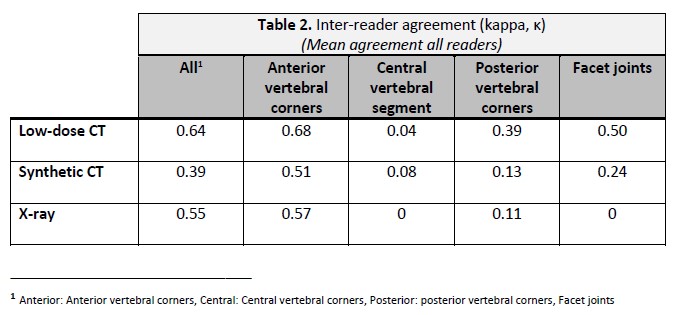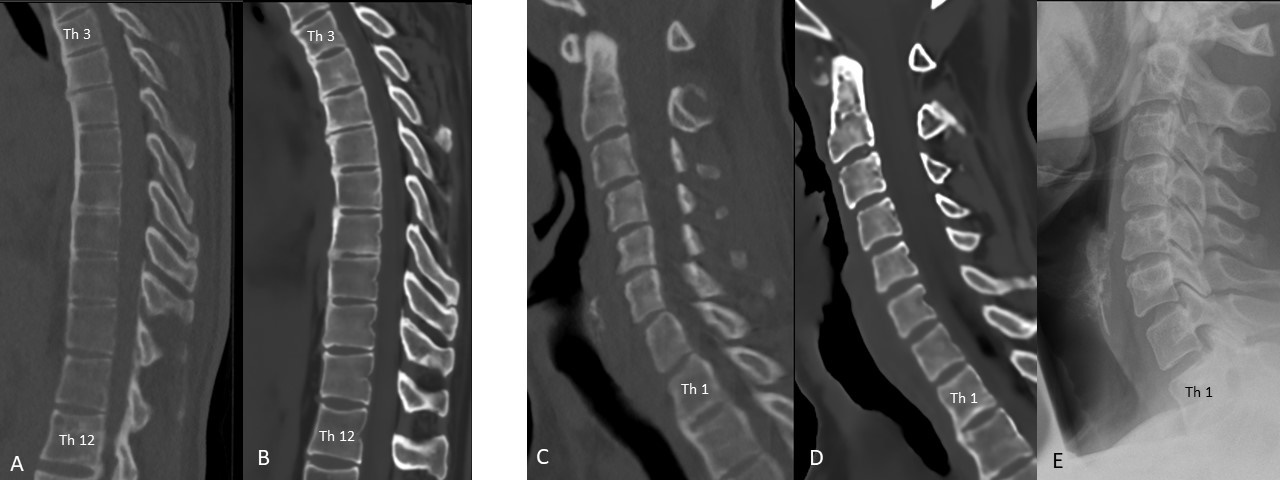Session Information
Session Type: Poster Session B
Session Time: 9:00AM-11:00AM
Background/Purpose: Whether a therapy has bone structure-modifying effects in the spine is crucial to determine since this is a prerequisite for a therapy to reduce development of permanent disability in patients with axial spondyloarthritis (axSpA). The current imaging modality for assessing structural progression in axSpA is conventional radiography (X-ray), using the modified Stoke Ankylosing Spondylitis Structural Score (mSASSS). However, this method is only able to show change over a minimum of two years, i.e. has a very low sensitivity to change. Alternative modalities are MRI and CT. MRI, unfortunately, cannot reliably visualize small syndesmophytes. CT is considered the gold standard but delivers substantial ionizing radiation. However, modern CT scanners allow the use of lower radiation doses (low-dose CT, ldCT).
The purpose of this study was, with ldCT as the gold standard reference, to assess and compare the ability of a novel deep-learning MRI-based method (“synthetic CT”, sCT), ldCT, and X-ray, in the assessment of structural damage in the spine in patients with axSpA.
Methods: X-ray (lumbar and cervical spine), ldCT, and sCT of the entire spine were performed in patients with axSpA (according to ASAS criteria) in a prospective observational cohort. sCT was made using the BoneMRI application (v1.6, MRIGuidance BV, Utrecht, NL) a quantitative 3D MRI technique based on a multiple gradient-echo sequence and a machine learning processing pipeline that can generate CT-like MR images. All images were scored by four readers for new bone formation (NBF; such as syndesmophytes and ankylosis). NBF was recorded as present vs. absent at the anterior, central, and posterior locations as defined by the Canada Denmark (CANDEN) MRI scoring system for the spine and at the facet joints. Images were anonymized and read blinded to information from other imaging modalities and to clinical information. Readers were trained before the exercise by mutual evaluation of 3 other ldCT and sCT image sets. Sensitivity and specificity of sCT and X-ray were calculated, with ldCT as the gold standard. Inter-reader agreement was assessed using kappa statistics.
Results: 17 patients with axSpA were included (8 women, 9 men; mean age 34.4 ± 9.5 [SD]). The mean overall number of NBF lesions scored was 186 for ldCT, 207 for sCT, and 37 for X-ray. Most findings were located at the anterior vertebral corners with a mean of 143 lesions on ldCT, 142 on sCT, and 35 on X-ray (Table 1). With ldCT as the reference, the overall sensitivity for sCT to detect NBF was 0.58, with a corresponding specificity of 0.97. sCT had the highest sensitivity (0.65) at the anterior corners (specificity 0.94). For levels that were assessable on X-ray (C2-Th1 and Th12-S1), the sensitivity was 0.47 for sCT and 0.16 for X-ray, with similar high specificities ( >0.90) for both methods.
The mean inter-reader agreement for all locations was 0.64 for ldCT, 0.39 for sCT, and 0.55 for X-ray, and best for the anterior corners (Table 2).
Conclusion: MRI-based synthetic CT showed very high specificity and a sensitivity much higher than X-ray, despite limited reader training. With more training, calibration, and optimization of the scoring procedure, sCT could become highly valuable in axSpA clinical trials.
To cite this abstract in AMA style:
Tromborg Willesen S, Vladimirova N, Moeller J, Hadsbjerg A, Vora B, Seven S, Pedersen S, Østergaard M. Improved Assessment of Structural Damage in the Spine in Patients with Axial Spondyloarthritis by MRI-based Synthetic CT: A Comparison with Low-dose CT and X-ray [abstract]. Arthritis Rheumatol. 2023; 75 (suppl 9). https://acrabstracts.org/abstract/improved-assessment-of-structural-damage-in-the-spine-in-patients-with-axial-spondyloarthritis-by-mri-based-synthetic-ct-a-comparison-with-low-dose-ct-and-x-ray/. Accessed .« Back to ACR Convergence 2023
ACR Meeting Abstracts - https://acrabstracts.org/abstract/improved-assessment-of-structural-damage-in-the-spine-in-patients-with-axial-spondyloarthritis-by-mri-based-synthetic-ct-a-comparison-with-low-dose-ct-and-x-ray/



